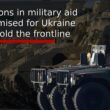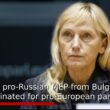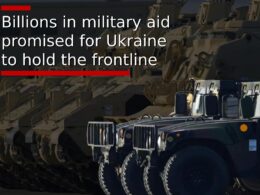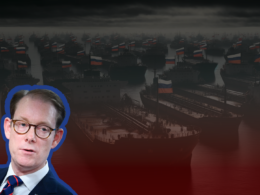As part of the sanctions imposed on the Russian Federation for the aggression against Ukraine, an agreement has been established to cap the price of Russian oil and petroleum products in order to reduce Russia’s ability to finance the war. The G7 and European countries, including EU countries, Albania, Bosnia and Herzegovina, Iceland, Liechtenstein, Norway, North Macedonia, Ukraine, Montenegro, Switzerland, as well as Australia and New Zealand, joined the oil price cap initiative.
The introduction of a “price cap” on Russian oil at 60 dollars per barrel can inflict a significant damage to the Russian military economy. While planning the invasion, Russia studied for a long time the experience of its “friends” – the outlaws of the world, Venezuela and Iran, in the matter of the shadow fleet. It is these countries that have the idea of circumventing sanctions both in the financial sphere and trade, including its largest budget-generating segment – oil trade.
So-called “ghost ships” are the vessels that disguise their ownership and movement to circumvent sanctions.
Getting ready to attack Ukraine, Russia began to buy tankers. In 2022, increased demand for tankers suitable for the transportation of Russian oil was observed worldwide. Unknown buyers and investors who wished to remain anonymous participated in many transactions. The number of transactions for the purchase of tankers with an unknown final buyer increased for all classes of tankers in 2022 compared to 2021: VLCC — from 2 to 19, Suezmaxes — from 4 to 14, Aframax — from 6 to 10, MR — from 9 to 27. Increased demand, fueled by Russia’s activity in the market, led to a general increase in tanker prices. The price of purchases, compared to the prices before the invasion in Ukraine in 2022, soared by an average of 2-2.5 times. It follows that Russia and Russian companies had to spend billions of dollars to create a shadow fleet.
Currently, Russia needs about 240 more tankers for the current level of production. Only recently, Russia purchased more than 100 oil tankers to create a “shadow fleet” to circumvent possible sanctions. In 2022, the average age of this fleet was 19 years, but thanks to continued purchases, it is now rapidly rejuvenating, and is only 12-15 years old.
However, it is not enough to buy/sell a ship to circumvent sanctions. To manage the shadow fleet in 2022, Russia created 864 new international companies in the maritime sphere. The owners of these ships are mainly located in Turkey (160 companies), China (120 companies), Greece (110 companies), UAE (100 companies), Hong Kong (83 companies) and India (40 companies).
When reviewing the Russian shadow fleet, it is possible to introduce the following classification of ships of the shadow fleet.
“Clean” fleet – tankers that do not demonstrate any suspicious actions (change of flag or confusing ownership structure). Such courts can be easily identified, they work within the framework of the law.
The “grey” fleet is a completely new phenomenon that appeared after the Russian invasion of Ukraine. Special companies are created for him, which hide his origin and owners, but at the same time give him a legal appearance and thereby protect him from sanctions. And in many cases, it is difficult to determine how legal the activities of such companies are, including in connection with sanctions. A significant number of them change the flag they operate under. Today, there are about 900 “gray” ships in the world (about 8% of the world fleet).
And finally, the “dark” fleet is ships that are used to transport illegal or sanctioned cargo. They turn off automatic identification systems, use technologies to hide the location and fake it. The Windward company counted approximately 1,100 ships of the “dark” fleet, which is about 10% of the global merchant fleet. Most of the vessels of the “gray” and “dark” fleet are over 16 years old — 63 and 83%, respectively. Last year, Russia entered the top five countries in terms of the number of ships of the “dark” fleet: 33% of all “dark” vessels based on the location of the owner’s company belong to Panama, 28% to Liberia, 15% to the Marshall Islands, 14% to Russia and 8% — to Malta. Moscow has become the absolute leader in terms of the number of vessels in the “gray” fleet: 42% of all “gray” vessels in the world by the location of the owner company belong to Russia, 21% to Liberia, 15% to the Marshall Islands.
What is the danger of Russia’s “shadow fleet”?
Why is it so difficult to trace a whole tanker into the sea, because this vessel is not a fishing boat and not a pleasure yacht of an oligarch?
For the transfer of oil from the “invisible” tankers of the Russian “shadow fleet”, two main schemes, honed by the Iranian and Venezuelan shadow fleets, are used.
The first scheme. A tanker in the Baltic Sea turns off the transponder and goes to the Russian port of Ust-Luga or Primorsk. He loads Russian oil there and goes to the sea, where a bigger tanker is waiting for him, where Russian oil is loaded. Then the shadow tanker-shuttle returns to its starting point and turns on the transponder, that is, it appears again on the radars. At the same time, officially, the tanker, as it was in the middle of the Baltic Sea, remained there, simply temporarily turning off the transponder. But in fact, he made a trip to a Russian port for oil. It is impossible to trace his movement using the data of vessel-tracking sites. No one can record the volumes of Russian oil delivered this way. They do not fall into the field of view even of Western analysts who monitor the volumes of Russian oil supplies. Russia, in turn, deliberately stopped publishing data on both the production and export of Russian hydrocarbons due to sanctions pressure, in order not to give the USA and the EU reasons for an informational attack and actual actions. Also, Russia classified all possible data on oil production and exports.
The second scheme is in many ways similar to the previous one. Only in this case, the tanker does not hide when it enters and leaves a Russian port (already with Russian oil). It does it with the transponder “ON”, his movement can be tracked on specialized sites. But this tanker goes without specifying a specific destination. It will be impossible to see how this tanker arrives with Russian oil to a European port, for example, in the Netherlands. Because in the open sea, it turns off the transponder, secretly approaches a larger tanker into which he transships Russian oil. And already a large tanker delivers black gold to European or Asian ports.
Thus, Western analysts tracking the movement of Russian oil can include in the statistics, in addition to official deliveries, deliveries according to the second – semi-grey – scheme. But the export of Russian oil, proceeding according to the first scheme, will not be taken into account. Why does the shuttle tanker (hidden or secret) not deliver Russian oil to European ports by itself, but transfers it to the shoulders of a large tanker? Most likely, the Kremlin initially calculated the possibility of introducing an EU oil embargo.
It is not by chance that a shuttle tanker transships Russian oil into the sea onto a tanker with a large deadweight. Such tankers can be used to internally mix Russian oil with some other oil and obtain a third grade that is not subject to sanctions. After all, if you mix oil of Russian origin with another oil in the proportion of 49% to 51%, then according to the papers, the oil turns into “Turkish”, “Indian”, or any other mixture. Overloading oil from one side to another is not prohibited. And in this case, there are no risks for the company that delivers Russian oil to the buyer as part of the other. It becomes almost impossible to prove that there is Russian oil there. Russia is forced to use similar gray schemes in the Baltic Sea, because there are no friendly countries around the Baltic countries, Poland, Scandinavia.
But in the Black Sea, the situation is somewhat different. In the Black Sea, there is Turkey, which became Russia’s intermediary in the sale of its oil on the world market, but, of course, not for free. Turkey can also mix Russian oil with Azerbaijani or other oil. Turkey actually became a “complex” player. Not only can it legalize Russian oil and petroleum products, but absolutely all goods from Europe can go through Turkey, which now cannot directly reach Russia by land and sea.
Unable to unload in Europe, ships are sent to sea terminals in Turkey, Saudi Arabia, UAE, Morocco and other countries. For several months of the embargo, the thin diesel streams flowing from Russia to these countries have turned into full-flowing rivers.
Russian tankers are also actively transshipping oil in Greek bays – spotted near the coast of the island. Karistios, – in the same place where Transmorphflot vessels used to pump Iranian oil, near the island of Euboea, in the Gulf of Lakonikos. Similar activity was observed near Ceuta, the Spanish enclave in North Africa, as well as near the Canary Islands, the Azores and Cape Verde.
But if sts – transshipment at sea (ship-to-ship) is not an extraordinary unsafe operation, then what is the danger of the “shadow fleet”?
The main danger of this shadow fleet lies in two factors. The first is the age of the ships used in the shadow fleet by such countries, because all the inhabitants of the Earth know the footage of environmental disasters at sea during oil spills. In the overwhelming majority, these are tankers that have served their warranty period, which are not accepted by most of the world’s ports.” The second is the disconnection of navigation equipment by such ships. It is obvious that a ship traveling in any weather in the ocean, in seas, and especially in straits, with the transponder turned off, hides its location for the purpose of “shadow” oil transportation, but at the same time it becomes practically invisible to other ships traveling on neighboring courses. During the trial, beacons are not simply turned off, but the technology of coordinate exchange is used. So they hide their location and continue to use the insurance of Western companies. It is also possible to note the existence of a third factor, which is rather a consequence, but still can be considered separately, the lack of global insurance of this type of vessels, because no self-respecting insurance company will insure such transport, its cargo, crew and possible risks. Thus, the “shadow fleet” of Russian oil tankers operates without third-party liability coverage from the International Group of Insurers (IGI), which increases the risks associated with oil spills.
It is worth noting that among the “fraternal” sanctioned oil-producing countries, there is a serious competition between them in the field of oil transportation. In recent months, Iran managed to maintain or even increase crude oil exports. But competition for courts is a source of growing tension in Moscow-Tehran relations. The “shadow fleets” of Iran and Russia are already beginning to compete with each other for buyers, routes, and tankers. Also, Moscow and Tehran still compete in the oil and gas market. But the Iranian and Russian regimes are united by growing international isolation, an internal political crisis, and enmity with the United States.
What to do with the Russian “Shadow Fleet”?
G7 countries and coalitions strive to limit Russia’s use of the “shadow fleet” of tankers to transport oil to bypass the price ceiling, complicating its use.
The measures taken by the G7 include restrictions on the sale of old tankers to unknown owners, the study of maritime and environmental risks when using “shadow fleet” tankers, and the introduction of sanctions against those who violate the restrictions of the G7 countries. All these “unknown owners” are mainly from the UAE and India and are subject to the scrutiny of monitoring agencies for compliance with sanctions from the imposing countries. But it is not limited to sanctions.
Considering the fact that Russia continues to depend on European tankers and insurance, a stricter application of legal mechanisms in this area is necessary. Punishment for violation of sanctions may, for example, provide for a 90-day ban on vessels providing maritime services or provide for the legislative seizure of such vessels.
Compulsory insurance should become a mandatory condition for the passage of tankers through the Danish Straits, Gibraltar, the Bosphorus and other sea corridors. It is at the stages of passage of corridors, and not only during mooring in ports.
It is necessary to prohibit the sale of tankers by countries that are part of a coalition that applies price restrictions on oil, outside the coalition, that is, to countries that do not apply price restrictions.
It is necessary to eliminate the danger of collisions and minimize environmental risks by imposing fines up to the requisition or confiscation of transport for endangering other participants in sea transportation by turning off navigational warning and recognition equipment.
Bottom prices for oil should be even lower, which will increase the impact of sanctions. Limiting the price below 30-25 US dollars per barrel (which still significantly exceeds the cost of production in Russia – on average 15 US dollars per barrel) would reduce Russia’s income by more than a half, by tens of billions of dollars. Ideally, it is necessary to introduce a full embargo or quota of Russian oil exports.
It is necessary to strengthen the monitoring and control of compliance with the oil price cap. The coalition countries must check the work of the bank in processing payments within the framework of transactions, and in case of exceeding the limit of the maximum price, register the violation and take measures to restore the legality of the payment within the established ceiling.
It is necessary to carry out stricter monitoring of the insurance sector serving sea transportation in order to check compliance with the established price ceiling.
Measures will be taken to eliminate “loopholes in oil refining” and change oil origin certificates. The countries that imposed sanctions should ban the import of petroleum products produced from Russian oil, regardless of its percentage share in the total mixture.
The coalition, led by the United States, monitors and imposes sanctions on shipowner companies that transport Russian oil as part of the “shadow fleet”, except for a complete ban on the entry of such ships into the ports of the Western coalition, which only leads to the fragmentation of the maritime transport market and the separation in that segment, which never enters the territorial waters of Western countries, should go further and confiscate both tankers and the transported oil subject to sanctions, which is sold above the established price wall, in order to make it impossible to ignore the sanctions and the desire of the Kremlin to continue the war in Ukraine.
It is an accomplished fact that the Russian Federation demonstratively ignores the principles of international law and order, violating the norms of international law. Historically, this country, which for centuries has cultivated the spirit of violence within its own country and periodically splashes it on its neighbors, understands only brute physical force and pressure from the world community. By attacking Ukraine, the Kremlin placed itself outside the legal field of the international security system and thus deserves the harshest treatment, up to the use of collective military force to restore the disturbed world order.








